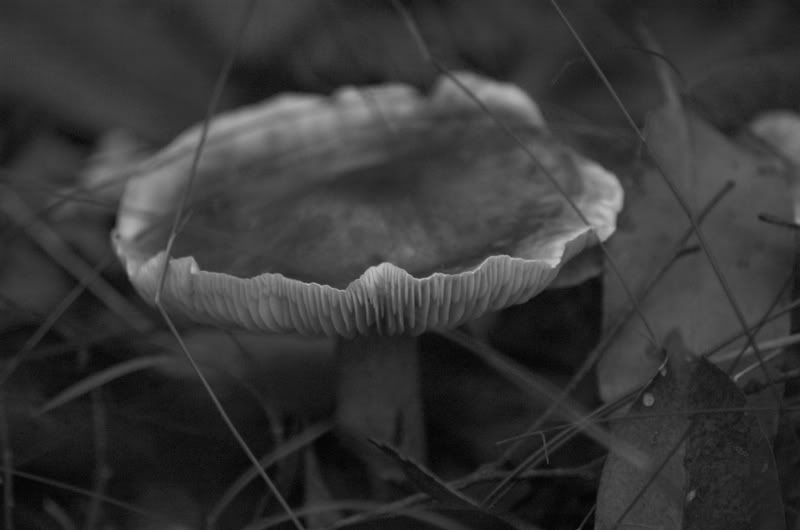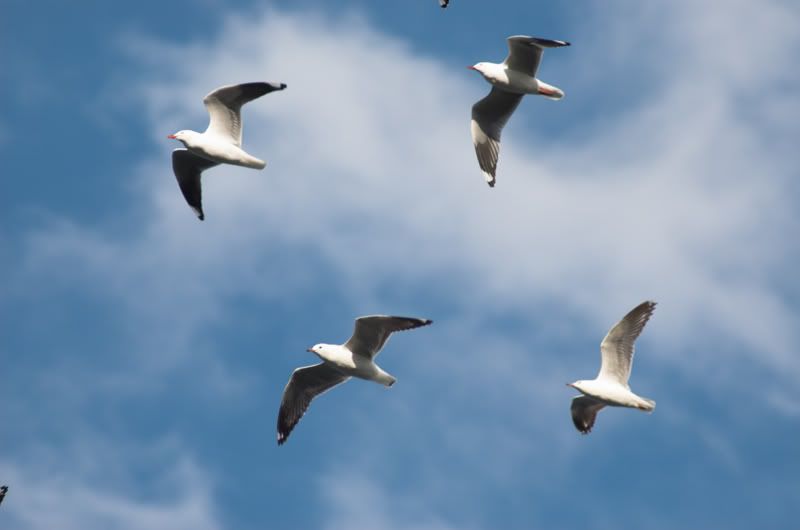Page 1 of 1
My Tamron 70-300mm just won't take good photos!

Posted:
Wed Jun 08, 2005 9:25 amby owen
Hey guys. I have previously had trouble taking shots in macro
mode with this lens and the other day I was down at the beach trying to get some simple shots of birds.
I was using it mainly at the 300mm length, however my shots at ISO 200 were coming out blurry so I set it to Auto ISO and still were blurry, so I set it manually to ISO 800 to hopefully get a higher shutter speed... guess what... still blurry. I was shooting in Aperture priority and set to wide open which is 6 at 300mm.
The lens is pretty good at the 70mm range - I've done a few portraits at that length, however I just can't get it right.
Any advice? I know it's a cheap lens... but I should get better shots out of it.

Posted:
Wed Jun 08, 2005 9:29 amby Hlop
Owen,
At 300mm you'll need a tripod to get a sharp macro. AF-C might help. Also, depending on subject, closest object
mode helps sometimes

Posted:
Wed Jun 08, 2005 9:32 amby owen
I was experimenting with the closest focus subject thingo as well, and had no luck... but I wasn't in macro
mode, I was just in normal
mode for the bird shots.

Posted:
Wed Jun 08, 2005 9:37 amby sheepie
were they blurry 'out of focus' or blurry 'birds moved'?
sounds like a silly question I know, but at that length and aperture, my guess is your shutter speed was too low for fast-moving birds.
can you let us know what shutter speed the shots went off at?
other than that, I have no experience with that lens so can't really help :/

Posted:
Wed Jun 08, 2005 9:48 amby Greg B
owen, I have that lens, and while it isn't in the same league as a Nikkor VR for the longer stuff, or dedicated macro for the macro stuff, you can get very satisfactory results.
So - and don't take this the wrong way - unless you have a distinctly dodgy lens, the problem is with what you are doing. The very good news about that is that it can be fixed




Posted:
Wed Jun 08, 2005 10:06 amby Photodude
Owen,
I have the Tamron and often use it to take pics of flying seagulls etc down the beach. I get good results at 300 mm handheld.
Either your particular lens is no good or you need to up the shutter speed and make sure your not shaking the camera whilst panning for the birds.
Good luck

John

Posted:
Wed Jun 08, 2005 10:22 amby Aussie Dave
Hi Owen
my suggestion would be to make sure you use Shutter Priority, rather than Aperture Priority. You really need to control the effects of blurring, not necessarily Depth Of Field.
At 300mm, you will certainly want to be shooting (at least) 1/300th sec., if not faster (remember the crop factor of x1.5 - so the sensor is seeing an image displayed as 450mm, not 300mm).
Now, as this is a relatively "slow lens", starting at f6 @ 300mm, you are going to need alot of light in order to shoot at these shutter speeds....even with bumping the ISO up. This is the trade-off you get when buying a "budget lens"......
Perhaps take everyone's suggestions onboard and give them a go. If this still does not solve your problems, this may indicate a lens fault.

Posted:
Wed Jun 08, 2005 10:44 amby leek
We might be able to suggest more options if you post one of the dodgy photos along with the EXIF data...

Posted:
Wed Jun 08, 2005 11:14 amby owen
Hey guys, I don't have any photos here with me at work, and I think I may have only one or two at home. ANyway I do need to try shooting in shutter priority
mode, that might give me better results.
The shots that were most in focus the birds appeared to be quite soft... and this was in the middle of a sunny day too. I'll post some examples later on today.
Thanks for the ideas.
Owen.

Posted:
Wed Jun 08, 2005 1:39 pmby Aussie Dave
owen wrote:The shots that were most in focus the birds appeared to be quite soft... and this was in the middle of a sunny day too. I'll post some examples later on today.
Thanks for the ideas.
Owen.
Most lenses, especially the budget lenses, will be soft at the 300mm extreme. I know when I shoot with my Sigma 70-300, I have to be vary wary of what shutter speeds I am shooting at, and always try to lean against something to steady the shot (if not using a tripod).

Posted:
Thu Jun 09, 2005 10:45 pmby ozimax
I use the 300mm extensively with reasonable results (you'll have to ask others for that one I suppose), just experiment and get as much light as you can.
I would definitely like a Nikkor 600mm superdoopersportsfantastic lens one day but I don't want to mortgage my four kids to do so!
Max


Posted:
Thu Jun 09, 2005 10:49 pmby johndec
I've got a Tamron 70-300 and it can be a bit Jekyll and Hyde. I've had some very sharp shots at 300mm, but others didn't quite work. If you pay VERY close attention to your settings, it will do the job for you.

Posted:
Tue Jun 14, 2005 3:56 pmby Neeper
I have this lens as well. And I get different results sometimes too. Good thing for the USM


Posted:
Tue Jun 14, 2005 4:37 pmby owen
Hey guys, an update on this. I went out yesterday and set the camera to shutter priority
mode with the shutter speed at 400, and also had Auto ISO set and I was getting much better results. It still doens't really focus quick enough to get good shots of birds, however I am not so scared to use it now.
Here's a shot that was taken in macro
mode, hand held:

This was at ISO 1600 and noise levels are really surprising... just the DOF is very shallow.
Anyway, previously this kind of shot would have been an unsharp mess, now it at least has some definition.
Thanks for the help.
Hi

Posted:
Tue Jun 14, 2005 4:42 pmby yeocsa
Hi Owen,
Please some pictures along with EXIF.
As your lens goes to f6 at the 300 end, AF would be slow to respond. If the birds are flying pretty fast and the light levels aren't high, you would not get very sharp pictures naturally.
It is not an ISO problem rather the AF of the camera and lens just could not reach that level of performance at f6.
To use the combo for birding, position yourself such that you have good direct light onto the birds. This way, you will have higher chances of getting good pictures. The best time time is sunny blue skies.
regards,
Arthur
Re: Hi

Posted:
Tue Jun 14, 2005 8:10 pmby Aussie Dave
yeocsa wrote:Hi Owen,
Please some pictures along with EXIF.
As your lens goes to f6 at the 300 end, AF would be slow to respond. If the birds are flying pretty fast and the light levels aren't high, you would not get very sharp pictures naturally.
It is not an ISO problem rather the AF of the camera and lens just could not reach that level of performance at f6.
To use the combo for birding, position yourself such that you have good direct light onto the birds. This way, you will have higher chances of getting good pictures. The best time time is sunny blue skies.
regards,
Arthur
good advice Arthur !
Owen , good to hear you experienced some improvement from your previous attempts with that lens, using suggestions offered up by the members on this forum. Without spending oodles of money on superior lenses, you'll be behind the 8-ball is some situation, but if you keep working at it you will soon get to know what you can and cannot do with the lens and should be able to maximise it to it's fullest.
Perhaps you can begin to dabble in "manual focussing" ??
Also, when using this lens in macro
mode, the DOF you'll be playing with will probably be counted in mm rather than feet or metres (which makes macro shooting something that requires a lot of practice)


Posted:
Tue Jun 14, 2005 8:59 pmby owen
Yeah I'm pleased with the results, compared with what I used to get.
I'll try to post an image of the birdies soon, along with exif.

Posted:
Tue Jun 14, 2005 9:22 pmby owen

EXIF:
1/400th
f/8
shutter priority
ISO 200
focal length: 300mm
Hi

Posted:
Tue Jun 14, 2005 10:02 pmby yeocsa
Hi Owen,
There's nothing wrong with your lens. You will need to understand more intimately the limitation and capability of your camera, lens and your skills.
From the picture you posted, assuming that you are using the centre focusing sensor, the focus is on the sky not on the birds. If you are using the outer sensors to focus on any one of the birds, the AF will have trouble keeping up. Only the centre sensor is a cross sensor (detecting vertical and horizontal). The AF will definitely hunt. If you use AFC, the result will be worst. Using manual focus could help but need greater handling skill required of you.
Did you pan the direction of the flight. If you do, it would help to keep one sensor (preferably the centre sensor) on one of the birds. Use continous frames so that you have a higher chance of getting the right shot.
To get good bird flights, you need to:-
1. move to a better location. i can see shadows cast by the sun. We don't want the shadows.
2. focus on one bird. one subject. one focal point. keep it simple.
3. get nearer to the bird. A bigger subject helps the AF to perform and allows your lens to capture the details. More would be expected of the lens if the subject get smaller - more resolving power is needed.
4. use the largest aperture your lens allow. use ISO 800. denoise as part of your post processing. Most bird shots require about f5.6 to f8.
5. practice with stationery birds first. if you can get the picture tact sharp at 300mm, then try taking flying birds. Use the centre AF to focus on the bird's eye and see if you can get the head sharp. Once you can do that, try manual focus, train your eyes to check the sharpness level through the viewfinder.
If you can do all 5 items listed, you will definitely see a marked improvements in your pictures.
regards,
Arthur

Posted:
Tue Jun 14, 2005 10:09 pmby owen
Hi Arthur. Thanks for yet another detailed, instructive post. The focusing method for this shot was the closest subject setting... I figured the camera should be smart enough to tell that the birds are closer than the clouds.
I will definitely try your suggestions and see how I go. You guys that make up this forum are so helpful!

